-
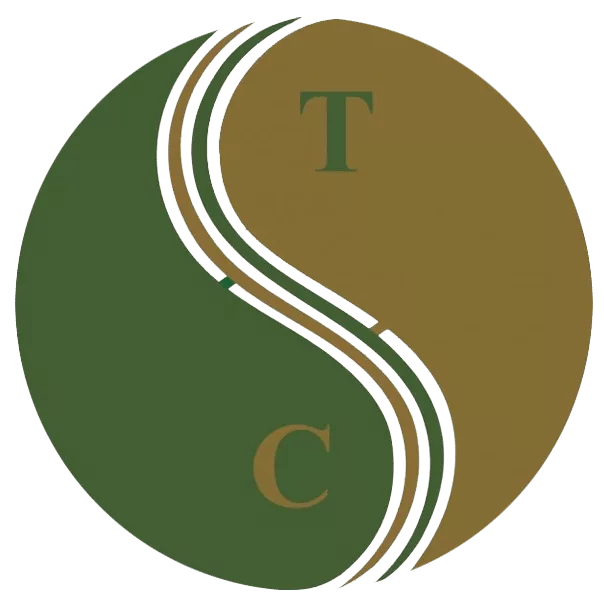 Art of Wellness Acupuncture & Traditional Chinese Medicine (TCM)11704 Wilshire Blvd, Suite 295, Los Angeles, CA, 90025
Art of Wellness Acupuncture & Traditional Chinese Medicine (TCM)11704 Wilshire Blvd, Suite 295, Los Angeles, CA, 90025
myartofwellness@gmail.com310-451-5522 Office Hours
MonClosedTue7:30 am --4 pmWed7:30 am --4 pmThu7:30 am -- 4 pmFri7:30 am -- 4 pmSat7:30 am -- 4 pmSunClosedOur office opens from Tuesdays to Saturdays 7:30 am to 4 pm, will be closed on Memorial day, Independent day, Labor day, Thanksgiving day, Christmas and New year.
-
Recent Posts
- Chinese New Year 2026: Year of the Horse
- Acupuncture and TCM Treatment for Perimenopause Symptoms
- How to Treat Insulin Resistance With Acupuncture and TCM
- How to Treat Metabolic Syndrome With Acupuncture and TCM
- How to Treat Syncope With Acupuncture and TCM
- How to Treat Thoracic Outlet Syndrome With Acupuncture and TCM
- How to Treat Dupuytren’s Contracture With Acupuncture and TCM
- How to Treat Nutcracker Syndrome With Acupuncture and TCM
- How to Treat Rosacea With Acupuncture and TCM
- How to Treat Perioral Dermatitis With Acupuncture and TCM
- Lymphatic Drainage With Acupuncture and TCM
- How to Treat Turf Toe With Acupuncture
- How to Treat Nerve Pain With Acupuncture and TCM
- How to Treat Watery Eyes With Acupuncture and TCM
- How to Treat Ovarian Cysts With Acupuncture and TCM
- How to Treat Dystonia With Acupuncture and TCM
- Sign up to receive news and updates and get my free report:“The Top 10 Reasons to Try Acupuncture”

December 2025 M T W T F S S 1 2 3 4 5 6 7 8 9 10 11 12 13 14 15 16 17 18 19 20 21 22 23 24 25 26 27 28 29 30 31
Acupuncture
How to Treat MCAS With Acupuncture and TCM
By Xiaomei Cai, L.Ac., Ph.D. and Qineng Tan, L.Ac., Ph.D.
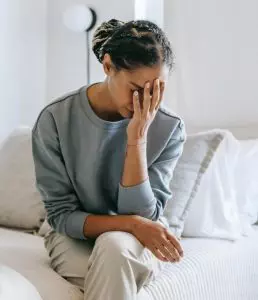
Shortness of breath, dyspnea? SIBO or fungal infections? Sensitive to smells? Signs of orthostatic low blood pressure? Itchy skin rash or hives? Musculoskeletal pain, joint pain? These can be some of the many different MCAS symptoms. Acupuncture and TCM can offer alternative treatment for MCAS, or mast cell activation disorders.
Mast Cell Activation Syndrome (MCAS) is a complex and often underdiagnosed condition characterized by the inappropriate activation of mast cells, which are immune cells involved in allergic and inflammatory responses throughout the body.
In short, mast cells are what cause people to have an allergic reaction to something. When mast cells encounter an allergen (or sometimes a medication, infection, or insect venom), antibodies inside them surface and send out “mediators.” Mast cells can produce hundreds of different types of mediators. These include histamine, leukotrienes and cytokines.
In MCAS, mast cells release excessive amounts of mediators, leading to a wide range of symptoms affecting various organ systems throughout the body. There are so many different mediators that science is not yet able to pinpoint which mediators may be causing which symptoms, in many cases.
This systemic activation of mast cells can occur spontaneously or in response to triggers such as stress, exercise, medications, infections, or environmental factors.
The symptoms of MCAS can vary widely among individuals and may mimic those of other conditions, making diagnosis challenging. There are five categories of MCAS symptom, affecting different parts or systems of the body:
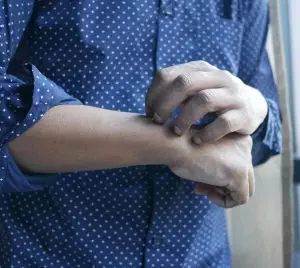
Skin-related MCAS Symptoms:
Itching (pruritus)
Hives (urticaria)
Flushing or redness of the skin
Rashes or eczema-like lesions
Swelling (angioedema), particularly of the face, lips, tongue, or throat
Gastrointestinal MCAS Symptoms:
Abdominal pain or cramping
Nausea and vomiting
Diarrhea or constipation
Acid reflux or heartburn
Bloating or abdominal distension
Respiratory MCAS Symptoms:
Wheezing or difficulty breathing (dyspnea)
Chest tightness or pain
Coughing or throat clearing
Nasal congestion or runny nose
Sneezing or postnasal drip
Cardiovascular MCAS symptoms:
Rapid or irregular heartbeat (palpitations)
Low blood pressure (hypotension)
Fainting or near-fainting episodes (syncope)
Fluctuations in blood pressure upon standing (orthostatic hypotension)
Raynaud’s phenomenon (abnormal blood vessel spasm in response to cold or stress)
Neurological MCAS symptoms:
Headaches or migraines
Dizziness or lightheadedness
Cognitive dysfunction or brain fog
Anxiety or panic attacks
Fatigue or malaise
These symptoms can vary in severity and may occur intermittently or chronically.
What Causes MCAS?
Medical science is unclear about the underlying cause of MCAS. Mastocytosis is a different mast cell disorder, in which people have an elevated number of mast cells. However, with MCAS, people have a normal number of mast cells; they just behave in an exaggerated manner when triggered.
MCAS is “primary” when there is a particular genetic mutation, which may happen due to mastocytosis or monoclonal mast cell activation syndrome (MMAS,) in which there is a clonal line of mast cells.
In some cases, when a person also has a diagnosed autoimmune disorder, allergy, or infection the MCAS is considered “secondary,” meaning that the overactive mast cell activity may be stemming from that other primary condition.
A diagnosis of “Idiopathic MCAS” indicates that neither of the above factors is present.
MCAS can begin at any point in a person’s life, including during childhood.
MCAS Treatment
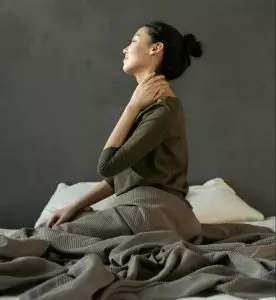
Treatment for Mast Cell Activation Syndrome (MCAS) in Western medicine typically involves a combination of medications and lifestyle modifications aimed at stabilizing mast cells and alleviating symptoms.
Antihistamines, such as H1 receptor blockers (e.g., loratadine, cetirizine) and H2 receptor blockers (e.g., famotidine, ranitidine), are commonly prescribed to reduce the effects of histamine released by mast cells.
Mast cell stabilizers, such as cromolyn sodium, can help prevent the release of inflammatory mediators from mast cells and may be used as preventive therapy. In cases of severe or refractory symptoms, corticosteroids or leukotriene inhibitors may be prescribed to suppress the immune response and reduce inflammation.
Medications to manage specific symptoms, such as gastrointestinal distress or cardiovascular symptoms, may be recommended.
Lifestyle modifications, such as avoiding known triggers, managing stress, and following a healthy diet, may also play a crucial role in managing MCAS symptoms.
It’s important for individuals with MCAS to work closely with their healthcare providers to develop a personalized treatment plan. Acupuncture and TCM can provide adjunct treatment for MCAS that address each patient’s unique symptoms and needs.
Can Acupuncture Help MCAS?
One of the central concepts of Traditional Chinese Medicine, which dates back many centuries, is that of the meridian system. The 12 meridians are channels of energy, or Qi, that flow throughout the body. Along the meridians are many acupoints: spots where Qi is activated when thin acupuncture needles or acupressure are applied to them.
But do the meridians exist as physical entities, or are they metaphorical?
Scientific research in the twentieth century sought to explain the various phenomena produced by the activation and manipulation of acupoints. It was found that both blood vessels and nerves are located near the acupoints in greater concentration than in other areas of the body. These studies suggested that acupuncture treatment functions through the vascular and nervous systems.
Later, further studies showed that acupuncture has effects on the production and releasing of hormones, such as endorphins, which has a analgesic effect of reducing pain.
The sensations that people feel as a result of acupuncture treatment cannot be fully explained by saying they are related to blood vessels, nerves, or hormones. Further questioning continued, asking if other cells or tissues could also be involved in how acupuncture works.
One female scientist, researcher, and professor in China, Jimei Song, hypothesized that activity around acupoints may be related to mast cell activation. This idea was Song’s Mast Cell Theory of Acupuncture (now called Song’s MC Theory for short, originally published in the Liaoning Journal of Traditional Chinese Medicine (TCM) in 1977.

Studies suggest that when an acupuncture needle penetrates the skin, mast cells are released, which then in turn, affect the blood vessels and nerves, leading to both sensations experienced by the patient in the moments, and systemic effects on the release of histamines, serotonin, and other chemicals than go on to create systemic effects. This is now considered a milestone in TCM research.
Acupuncture has been shown to have a positive effect on histamine response. Specific Chinese herbal formulas have also been shown to be effective in dampening mast cell activation. Compounds found in some herbs can help inhibit the production of cytokines.
An acupuncturist is able to address the problem both at its root, and help take care of the wide variety of symptoms a person may be experiencing. Acupuncture treatment can help relieve problems like itchy skin rash, sensitivities, orthostatic low blood pressure, and joint pain, all in one treatment session. A personalized herb formula can be prescribed to suit each individual patient.
Acupuncture Near Me for MCAS in Los Angeles
MCAS can mimic many other conditions and be difficult to diagnose and treat. This is what makes acupuncture, herbs, and moxibustion excellent modalities for helping to relieve MCAS symptoms such as: dizziness, headaches, musculoskeletal pain, insomnia, anxiety, hives, GERD, SIBO, IBS, interstitial cystitis bladder pressure, and more. Acupuncture and TCM can offer an adjunct or alternative treatment for MCAS symptoms.
*This article is for education from the perspective of Traditional Chinese Medicine only. The education provided by this article is not approved by FDA to diagnose, prevent, treat and cure human diseases. It should not stop you from consulting with your physician for your medical conditions. Traditional Chinese Medicine is based on Qi, which is an invisible force that usually cannot be observed by modern science. Because science focuses on testing ideas about the natural world with evidence obtained through observation, these aspects of acupuncture can’t be studied by science. Therefore acupuncture and Chinese herbs are often not supported by double-blind, randomized trials, and they are considered alternative medicine therapies in the United States.
How to Treat Costochondritis With Acupuncture and TCM
By Qineng Tan, L.Ac. Ph.D. and Xiaomei Cai, L.Ac., Ph.D.

Chest pain? Rib pain, sternum pain? These can be costochondritis symptoms, caused by inflammation of the cartilage that connects the ribs to the sternum. Acupuncture and TCM can provide costochondritis treatment to relieve pain and inflammation.
Costochondritis is a pain condition caused by inflammation of cartilage in the rib cage. It can be scary, because the pain can feel like a heart attack or a symptom of heart disease.
It is quite common for people who are experiencing costochondritis pain to visit the emergency room complaining of chest pain. Almost 10% of ER visits are related to chest pain symptoms, and a significant number of those turn out to be related to something other than heart problems.
Sometimes called “chest wall pain syndrome,” or costosternal syndrome, costochondritis is considered a syndrome because it presents as a set of symptoms that often does not have a clear cause.
Possible causes of costochondritis include:
- Trauma or injury to the chest or ribs
- Persistent cough
- Repeated bouts of vomiting
- Chest or lung infection
- Allergies that affect the lungs
- Fibromyalgia
- Tietze syndrome
Suddenly doing some kind of heavy labor or intense workout that you’re not used to, that causes you to be winded, could cause inflammation of the chest. Playing contact sports in which you may be tackled or collide with another player or get hit hard with a ball in the chest could also cause costochondritis.
Tietze syndrome is a rare condition in which the cartilage connecting the ribs to the breastbone becomes inflamed and swollen. With Tietze syndrome, the pain and swelling in the chest is usually higher up, around the second and third ribs.
Costochondritis pain usually is felt more on the left side of the chest, radiating outward, and there isn’t any swelling involved.
Rib pain may be exacerbated when lying down, which can make it difficult to sleep comfortably.
Costochondritis is most commonly experienced by people in middle age (40-50s), but it can occur in children and adolescents, as well as adults.
In most cases, costochondritis is temporary. However, costochondritis pain can limit your activities and be debilitating for weeks, or even months. One study showed that up to a third of adults reported pain persisting beyond a year.
Acupuncture has been shown to help alleviate costochondritis pain, often in a matter of weeks.
Costochondritis Symptoms
Costochondritis pain can range anywhere from a slight tenderness to severe chest pain. In mild cases, the pain may go away in a matter of days, but in other cases, the pain can become serious.
Symptoms of costochondritis include:
- Sharp chest pain
- Chest pressure, chest ache, tenderness in breastbone
- Pain on the left side of chest, to the left of the breastbone
- Rib pain in more than one rib
- Pain radiating to shoulders and/or arms
- Chest pain when coughing, sneezing, or taking a deep breath
- Pain in chest when reaching up or twisting the torso
- Rib pain when lying down
- Pain when hugging someone
- Pain when putting on a seatbelt
Medical Diagnosis and Costochondritis Treatment
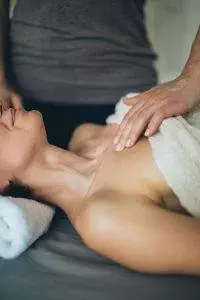
Other than the doctor palpating the area around your breastbone and ribs, there is no specific test to determine if you have costochondritis.
Chest pain can be an indicator of a variety of health conditions, including heart problems or lung problems, so it is always important to get it checked out with a healthcare professional. They will rule out other problems by ordering an EKG or chest X-ray in order to get to a diagnosis of costochondritis.
Treatment will consist of recommendations for ways to alleviate pain. Over-the-counter nonsteroidal anti-inflammatory drugs (NSAIDs) such as ibuprofen (Advil, Motrin IB) or naproxen (Aleve) can help reduce inflammation and pain.
In cases of more severe or persistent pain, a doctor may prescribe stronger pain medications such as prescription-strength Motrin or muscle relaxers.
Applying heat or cold packs to the affected area can help reduce inflammation and alleviate pain. Some individuals find relief by alternating between heat and cold therapy.
In cases where pain is severe and not responding to other treatments, corticosteroid injections directly into the affected area may provide temporary relief by reducing inflammation.
Acupuncture treatment is a great way to relieve pain and reduce inflammation, without the side effects that can result from using pain medications or steroids for several weeks or months.
Can Acupuncture Help Costochondritis?
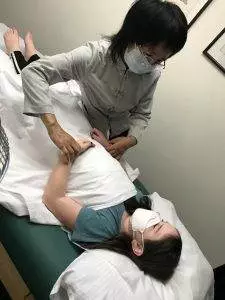
Acupuncture has been used for many centuries to treat pain and inflammation. Now, research is able to show how and why this modality is able to regulate inflammatory responses. Acupuncture affects the nerve signaling that produces hormones like dopamine and can reduce the production of cytokine storms. This is why acupuncture can help relieve inflammation and chest pain of costochondritis.
In TCM theory, pain and inflammation are usually considered to occur because of stagnation, or stasis, of blood and/or Qi (life force energy). The same symptoms can occur in different individuals because of different imbalances in the organs systems that are causing the blockages and different pathogenic factors, such as excess heat, dampness, etc.
Costochondritis inflammation can occur due to dampness and stagnation of Qi in the liver, spleen, and/or kidney systems. Depending on each patient’s specific situation, your acupuncturist will choose acupoints to open channels, clear dampness, heat, and phlegm. This allows for Qi and blood to flow smoothly again, cooling down the inflammation and relieving pain.
One case study of six women who were treated for costochondritis pain with acupuncture found that all patients reported improvement and were able to discontinue taking OTC pain medications.
One pediatric study looked at young students suffering from costochondritis; they were missing school, limiting their sports, dance, and work, and having trouble sleeping. After 4-6 weeks of acupuncture treatment, these patients reported a significant reduction in pain, and were able to resume their usual activities.
Not only is acupuncture treatment effective for relief of costochondritis pain; it can work quickly. In many cases, patients feel better after one or two treatments.
Acupuncture Near Me for Costochondritis in Los Angeles Area
Dr. Tan and Dr. Cai of Art of Wellness Acupuncture in West L.A. have been helping treat pain conditions for over 35 years. Our office is a home away from home where patients are able to relax and find relief from pain and inflammation. If you or someone you love is experiencing chest pain due to costochondritis, please do not hesitate to come in for a consultation.
*This article is for education from the perspective of Traditional Chinese Medicine only. The education provided by this article is not approved by FDA to diagnose, prevent, treat and cure human diseases. It should not stop you from consulting with your physician for your medical conditions. Traditional Chinese Medicine is based on Qi, which is an invisible force that usually cannot be observed by modern science. Because science focuses on testing ideas about the natural world with evidence obtained through observation, these aspects of acupuncture can’t be studied by science. Therefore acupuncture and Chinese herbs are often not supported by double-blind, randomized trials, and they are considered alternative medicine therapies in the United States.
How to Treat Gastroparesis With Acupuncture and TCM
By Qineng Tan, L.Ac., Ph.D. and Xiaomei Cai, L.Ac. Ph.D.

Bloated stomach, indigestion? Acid reflux, regurgitating food? Abdominal pain or nausea? These can be signs of gastroparesis, also known as stomach paralysis. Acupuncture and TCM can help relieve gastroparesis symptoms.
What is gastroparesis? Gastric paralysis is a functional problem that occurs when the stomach muscles and the nerves that are connected to them aren’t activating normally. Weak stomach contractions lead to delayed emptying of the stomach into the small intestine.
Gastroparesis impacts your digestion, triggering uncomfortable symptoms, and limiting your ability to get proper nutrition and keep your blood sugar levels steady.
There are different types of gastroparesis.
- Diabetes-related gastroparesis – a side effect of diabetes
- Post-surgical gastroparesis – occurs after surgery, such as gallbladder or pancreas surgery, gastric bypass surgery, stomach surgery for ulcer, or hysterectomy
- Idiopathic gastroparesis – occurs without a clear explanation
Most people experience idiopathic gastroparesis, which means that doctors cannot necessarily identify what causes gastroparesis in many cases.
Some medications can delay stomach emptying, including narcotic pain medications like codeine, morphine, or oxycodone. Medications that work on nerve signals, such as those used to treat overactive bladder, can delay gastric emptying.
Scleroderma, an autoimmune condition that affects collagen production and smooth muscle tissues, can lead to gastroparesis. Parkinson’s disease, which affects nerve signals, can lead to delayed emptying of the stomach. Hypothyroidism can also affect nutrition and digestion, as can eating disorders, metabolic disorders, and/or chronic fatigue.
Acupuncture is a good modality for helping to relieve gastroparesis symptoms, because it works on the nervous system, to help restore the proper signaling to muscles.
Rumination Syndrome
Gastroparesis is sometimes confused with “rumination syndrome.” Rumination syndrome refers to the regular regurgitation of undigested food. People with this syndrome often regurgitate undigested food back up shortly after a meal. This condition is usually related to the functioning of muscles of the diaphragm and unconscious behaviors around chewing and swallowing.
Gastroparesis Symptoms

The most common signs of gastroparesis are bloating, pain, nausea, and feeling full quickly when you eat.
Other symptoms of gastroparesis include:
- Feeling full quickly when eating
- Nausea, feeling nauseous after eating
- Vomiting, spitting up undigested food after eating
- Bloating, bloated stomach, abdominal bloating, abdominal cramping, stomach cramps, SIBO
- Belching, burping
- Acid reflux, heartburn
- High blood sugar, low blood sugar
- Lack of appetite
- Weight loss
- Malnutrition
Gastroparesis needs to be addressed, as it can compromise your overall health by blocking you from getting proper nutrition from your food.
Gastroparesis Treatment
Medical treatment for gastroparesis will depend on which type a person seems to have. If a person has diabetes-related gastroparesis, for example, treatment will necessitate better management of blood sugar levels.
Initial diagnosis usually involves imaging tests to see what is happening with the stomach and if there may be a blockage. Gastric motility tests help doctors see how your stomach muscles are working.
People will often be advised to change their dietary habits: possibly following a liquid diet for a period of time, or eating smaller meals throughout the day. You may be told to avoid fats and fiber, as these macronutrients can contribute to delayed stomach emptying.
In some cases, intravenous feeding or tube feeding may be necessary, if a person is severely undernourished due to gastroparesis.
Antiemetic medications may be prescribed to help with nausea and vomiting. Proton pump inhibitors may be recommended to help with acid reflux symptoms.
There are some medications that can help promote better gastric emptying by stimulating more muscular contractions. Erythromycin and metoclopramide are two drugs used to treat gastroparesis. These medications can have side effects, like stomach cramps, nausea and constipation. They can also have negative interactions with other medications.
If these treatments are not helping, surgical options may be offered. A gastrostomy or may be inserted to help drain the stomach. A jejunostomy tube can be placed to bypass the stomach, so that nutrition gets into the intestines. A pyloroplasty is an operation in which the muscular valve of the stomach is widened.
Newer, experimental treatments involve placing electrodes on the stomach to help activate contractions. Botox injections have also been tried, as a way to calm spasms in the stomach.
Acupuncture treatment can help relieve gastroparesis symptoms without side effects or invasive procedures.
Can Acupuncture Help Gastroparesis?

According to TCM theory, gastroparesis can be caused by a deficiency of stomach and/or spleen Qi. Part of the TCM treatment protocol for gastroparesis might involve using herbs and certain foods to help warm and nourish the spleen. Acupuncture treatment can help improve muscular function, as well help to relieve stomach pain.
The motility of the gastrointestinal system is controlled by nerve and electric impulses. Acupuncture, and in particular, electro-acupuncture, can have a positive effect on stimulating electrical activity and restoring neural pathways within the body.
Acupuncture has been shown to be helpful for relieving many GI symptoms, like nausea and bloating. This makes it a good treatment for many types of gastric disorders and stomach problems.
In one study, three different groups of people were all given acupuncture treatment, with emphasis on different acupoints used for each group. All three groups of patients had significant improvement in their gastroparesis symptoms.
Specifically, testing with barium meal showed that acupuncture helped improve the speed of stomach emptying. Patients also reported positive changes in their feeling of fullness after a meal and experienced less bloating.
One case study of a woman in her 60s who had been suffering for two years with gastroparesis symptoms showed significant improvement of nausea, timely stomach emptying, and energy levels after just four acupuncture treatments.
Another case study of a man in his 60s who presented with symptoms of fullness, stomach pain and distension, with delayed stomach emptying, ended with complete resolution of his symptoms after eleven acupuncture treatment sessions.
Acupuncture Near Me for Gastroparesis in Los Angeles
At Art of Wellness in West Los Angeles, Doctors Tan and Cai have over 35 years of experience helping people find relief from all kinds of gastrointestinal symptoms and stomach problems, including: IBS, stomach ulcer, colitis, Crohn’s disease, diverticulitis, nausea, diarrhea, and constipation. It’s worth trying acupuncture to see if it can help relieve gastroparesis symptoms for you.
*This article is for education from the perspective of Traditional Chinese Medicine only. The education provided by this article is not approved by FDA to diagnose, prevent, treat and cure human diseases. It should not stop you from consulting with your physician for your medical conditions. Traditional Chinese Medicine is based on Qi, which is an invisible force that usually cannot be observed by modern science. Because science focuses on testing ideas about the natural world with evidence obtained through observation, these aspects of acupuncture can’t be studied by science. Therefore acupuncture and Chinese herbs are often not supported by double-blind, randomized trials, and they are considered alternative medicine therapies in the United States.
How To Treat Sleep Apnea With Acupuncture and TCM
By Qineng Tan, L.Ac., Ph.D. and Xiaomei Cai, L.Ac., Ph.D.
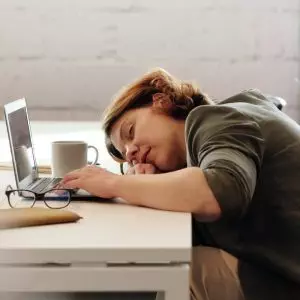
Does your partner say you’re snoring loudly or that you stop breathing during sleep? Waking up with headaches or dry mouth? These can be signs of sleep apnea. Sleep apnea and snoring often go together. Acupuncture and TCM offer sleep apnea treatment and CPAP alternatives to help you stop snoring and get more restful sleep.
Sleep apnea, or obstructive sleep apnea (OSA), is a common breathing disorder that occurs when you are sleeping. When you have apnea, your breathing can stop and start repeatedly during the night due to throat muscles relaxing and blocking your airway while you sleep.
Can you have sleep apnea without snoring? Snoring is just one sign of sleep apnea. It is possible to snore and not have sleep apnea, and it is possible to have sleep apnea and not snore.
One type of sleep apnea, called central sleep apnea (CSA), is less common but particularly dangerous, because in these cases the brain is not automatically sending signals to start breathing again when it stops. With CSA, a person may not make any of the loud snoring sounds usually associated with obstructive sleep apnea.
The overall symptoms of obstructive sleep apnea and central sleep apnea are similar. With both types, sleep is interrupted throughout the night, as the lack of oxygen triggers a reflex that wakes you up, perhaps for just a second or two, so that you start breathing again. Most people are not consciously aware of this survival instinct when it happens.
Top 10 Sleep Apnea Symptoms
Many people suffer from sleep apnea without being aware of it, because if you don’t have another person observing what is happening while you’re sleeping, you may not realize that there is something wrong with your nighttime breathing and sleep patterns.
If you have any of these signs of sleep apnea, you may need to seek sleep apnea testing and treatment:
- Suddenly waking up gasping, choking, or feeling shortness of breath
- Episodes of stopped breathing during sleep
- Snoring while sleeping, loud snoring
- Dry mouth, waking up with a sore throat
- Insomnia, trouble staying asleep
- Sleepy during the day, daytime drowsiness, hypersomnia
- Difficulty concentrating, trouble focusing
- Morning headaches, headache upon waking
- Moodiness, mood swings
- High blood pressure
It is important to seek help to resolve sleep apnea, because it has a negative impact on your ability to get restful sleep. You are likely to feel fatigued, foggy-headed, and irritable as you go about your daily routine. Sleep apnea can also compromise your cardiovascular health, increasing the chances of high blood pressure and arrhythmia.
What Causes Sleep Apnea?

Anyone can have sleep apnea, including children. However, there are some risk factors that might lead to you being more likely to experience sleep apnea. These include:
- Smoking – people who smoke are much more like to have sleep apnea
- Age – older people are more likely to have sleep apnea
- Obesity – being overweight can increase the chances of sleep apnea
- Gender – men are much more likely that women to have sleep apnea
- Allergies, asthma, or other chronic nasal congestion issues or lung disease
- Impeded airway – tonsils, adenoids, a narrow throat, or a thicker neck can affect breathing during sleep
- Alcohol or other medications, including opioids, which can have a sedative effect
- Heart problems or diabetes
- PCOS – there is a high incidence of sleep apnea among people with PCOS
- Sleep position – sleeping on your back may increase the chance of snoring
Sleep Apnea Treatment
To determine if a person has sleep apnea and identify the specific type, doctors often conduct a sleep study session. During this session, individuals spend the night at a sleep center where their heart and breathing functions are monitored.
CPAP machines are widely regarded as the most effective treatment for sleep apnea. These anti-snoring devices can help promote more restful sleep, and reduce the risks associated with sleep apnea, such as heart disease.
However, a CPAPmachine does not address the underlying causes of obstructive sleep apnea (OSA) or central sleep apnea (CSA). Some individuals may experience issues like swallowing air, leading to gas and bloating. CPAP masks, which need to be strapped on, can also be uncomfortable. The noise of the machine can be disturbing both the user and their bed partner. It can be challenging for some patients to adapt to using the machine regularly, and without consistent use, they may not reap the full health benefits.
Alternatively, there are oral appliances available, such as mandibular advancement devices (MAD), which are essentially a sleep apnea mouth guard, worn to reposition the jaw and tongue, keeping the airway open during sleep. These appliances can also be effective in improving breathing during sleep. Compared to CPAP machines, they are quiet, discreet, and cost-effective. However, the key consideration is whether an individual can tolerate wearing the device, as some may experience dental pain, TMJ jaw pain, dry mouth, or excessive saliva.
Surgery for snoring and sleep apnea is typically recommended only when other treatment methods have proven ineffective. Various surgical procedures involve the removal of soft tissues, such as the uvula, tonsils, and adenoids.
TCM methods like acupuncture offer CPAP alternatives that may help you sleep better without uncomfortable devices or surgery.
Can Acupuncture Help Sleep Apnea?

According to the principles of Traditional Chinese Medicine (TCM), the spleen and stomach play a crucial role in converting nutrients from food and fluids into vital life energy known as Qi. This Qi is then transported to the heart and lungs.
TCM considers sleep apnea to be linked to issues such as phlegm accumulation and Qi stagnation, which are also associated with fatigue and insomnia. When phlegm gathers and stagnates in the spleen, it hinders the lungs from receiving the necessary Qi. Therefore, one possible explanation for sleep apnea is Spleen Deficiency accompanied by Qi Stagnation. This condition, characterized by dampness and phlegm, often leads to feelings of heaviness and bloating.
In certain cases, excessive internal heat can contribute to the problem. Snoring, excessive sweating, and waking up with a sore throat indicate the need to eliminate heat and toxins from the body.
A systematic review of studies, using acupuncture to treat obstructive sleep apnea concluded that acupuncture was a safe and effective way to reduce the number of breathing disturbances during sleep.
A study of patients in China with sleep apnea who were treated with acupuncture and herbs experienced a marked improvement in deep sleep, oxygen levels, and blood pressure.
Various trials have shown that acupuncture, and in particular electro-acupuncture, can be just as or even more effective that CPAP machines at improving oxygen saturation in the blood.
This can be great news for people who are looking for an alternative to CPAP machines, which can be difficult to adjust correctly and uncomfortable to use, not to mention expensive and potentially disturbing to one’s sleeping partner.
Acupuncture Near Me for Sleep Apnea
If you or your partner is losing precious, quality sleep to sleep apnea and/or snoring, it is important to get help. While conventional treatments work for some people, many people find CPAP machines and other devices for sleep apnea do not help them get the rest they need. Why not give acupuncture treatment for sleep apnea a try? TCM can help you get better sleep without discomfort or unwanted side effects.
*This article is for education from the perspective of Traditional Chinese Medicine only. The education provided by this article is not approved by FDA to diagnose, prevent, treat and cure human diseases. It should not stop you from consulting with your physician for your medical conditions. Traditional Chinese Medicine is based on Qi, which is an invisible force that usually cannot be observed by modern science. Because science focuses on testing ideas about the natural world with evidence obtained through observation, these aspects of acupuncture can’t be studied by science. Therefore acupuncture and Chinese herbs are often not supported by double-blind, randomized trials, and they are considered alternative medicine therapies in the United States.
How To Treat Baker’s Cyst With Acupuncture and TCM
By Qineng Tan, L.Ac., Ph.D. and Xiaomei Cai, L.Ac., Ph.D.

Swelling behind knee, lump behind knee, pain and swelling behind knee, knee stiffness? These can be Baker’s cyst symptoms. A Baker’s cyst in knee joint occurs when swelling in the knee forms a fluid-filled sac. Acupuncture treatment can help relieve Bakers cyst knee symptoms like knee pain and stiffness.
A Baker cyst, also known as a popliteal cyst, or synovial cyst, is a fluid-filled growth that develops in the back of the knee joint. In some cases, a Baker’s cyst causes knee pain, stiffness, and swelling; in other cases, there may be no Baker’s cyst signs and symptoms at all.
What causes Baker’s cyst? Usually, it is due to a knee injury, such as a cartilage tear, or arthritis in the knee joint. These types of problems cause inflammation in the knee, which can lead to the production of more synovial fluid than usual.
Synovial fluid is a thick, clear substance, similar to egg whites in consistency, that is present in the joints of the body to help lubricate their movements. It is produced by the synovium, a sort of bubble that surrounds joints like the knees, elbows, shoulders, and hips.
When the synovium becomes swollen and inflamed, due to injury or overuse of the joint, it may produce excess synovial fluid. In the case of a Baker’s cyst, the synovial fluid can build up in the knee joint, and form a bump, lump, or growth in the back of the knee.
People who have a history of knee injury, osteoarthritis, or rheumatoid arthritis may be more prone to developing Baker’s cysts.
Bakers cyst treatment is usually only indicated if a person is experiencing significant pain or limitation of movement. Acupuncture treatment can provide an adjunct or alternative Baker’s cyst therapy to help promote healing and relieve Baker’s knee symptoms.
Top 5 Baker’s Cyst Symptoms

Photo by Jenny Hill on Unsplash
Many people have a baker’s cyst knee without realizing it. If there is no pain, a person may not notice the lump behind knee.
Baker’s cyst signs and symptoms include:
- Knee pain, pain in the back of the knee
- Knee stiffness, stiff knee joint, especially when straightening the leg
- Swollen knee, swelling in knee joint
- Swelling goes away when knee is bent
- Pain and stiffness are worse after standing for a long time
More severe baker’s cyst symptoms could include redness and swelling, as the cyst gets larger.
In some cases, a baker’s cyst can rupture. If this happens, there may be swelling, redness, and a warm sensation in the calf area. Rupture of a baker’s cyst could cause pain or numbness in the calf, lack of blood flow to the lower leg, as the ruptured cyst could trap a nerve or artery in the knee or lower leg.
In extreme cases, a ruptured Baker’s cyst could lead to compartment syndrome, which could cause intense pain, foot drop, edema in the lower leg, and possibly, even an inability to move the foot or toes. If you believe your Baker’s cyst has ruptured, you should seek emergency care.
While, in most cases, a Baker’s cyst will eventually go on on its own, it is best to get a diagnosis and discuss your options. Acupuncture and TCM offer treatment of Baker’s cysts that is non-invasive and can help improve healing and prevent regrowth of the cyst.
Baker’s Cyst Treatment
Baker’s cyst signs and symptoms can be similar to those of a blood clot, or even a tumor. So, while a doctor can often diagnose a Baker’s cyst simply by palpating the area, they may also order imaging tests to be sure.
In many cases, doctors will prescribe over the counter pain medications and allow time for the cyst to go away on its own. You may be advised to limit activities that might aggravate the knee inflammation. Resting and elevating the knee for a few weeks might be recommended.
In some cases, a doctor may give cortisone injections to reduce knee swelling, or perform needle aspiration to drain the fluid from the cyst.
Surgery is generally only suggested in situations in which the knee pain has become chronic and inflammation does not seem to be going away.
Unfortunately, these medical treatments for Baker’s cyst may help bring relief, but it is quite common for the Baker’s cyst to come back again. Acupuncture treatment is not only a good way to bring symptomatic relief, but can help prevent the recurrence of Baker’s cysts.
Acupuncture has long been considered an excellent modality for treating knee pain due to all types of conditions. TCM offers an adjunct or alternative treatment for knee pain, without side effects that can come with pain medications or steroids.
Can Acupuncture Help Baker’s Cyst?
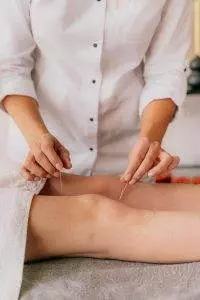
Acupuncture and TCM treatments with Chinese herb formulas have been used for centuries to treat knee injuries of all kinds.
According to TCM theory, arthritis in the knee that causes pain and stiffness is caused by stagnation that blocks the smooth flow of blood and Qi (life force energy). Acupuncture and herbs are used to address the underlying causes of blockages.
Injuries like a torn meniscus in the knee, or damage to the cartilage of the knee are very common, and it is also common for a person who has suffered such an injury to develop a Baker’s cyst later on. Full healing of cartilage can be helped with specific herbs that bring more nutrients to the damaged tissues.
Once a pattern of inflammation has begun, it can be difficult to get the swelling to go away. Small movements can trigger the inflammatory response if the area is not fully healed, and if other lifestyle habits are also causing a person to be prone to inflammation.
Chinese medicine looks at the situation holistically, treating the situation with acupuncture treatment, cupping, herbs, and nutrition, so that overall inflammation is reduced, and swelling and pressure is reduced, as well.
Herbal patches that are applied topically may be used in addition to herbal teas taken internally, to help relieve knee pain and swelling.
Cupping can also be helpful for healing and prevention of Baker’s cysts. One study compared patients with a popliteal cysts who were treated with acupuncture and cupping to patients who were given injections of prednisone. Both groups had high rates of effectiveness in terms of relief from the cysts, but recurrence of Baker’s cyst was significantly lower in the group that received TCM treatment as opposed to steroids.
Acupuncture Near Me for Baker’s Cyst, Los Angeles, CA
If you or someone you know has been suffering from knee pain and stiffness, due to a knee injury, arthritis, or diagnosed with Baker’s cysts on knee, it is worth seeking help from an acupuncturist experienced in working with orthopedic injuries, like Dr. Tan at Art of Wellness in West Los Angeles. TCM treatment for Baker’s cyst and other problems with the knee joint can not only help to relieve pain and increase range of movement; it can help prevent knee pain from coming back in the future.
*This article is for education from the perspective of Traditional Chinese Medicine only. The education provided by this article is not approved by FDA to diagnose, prevent, treat and cure human diseases. It should not stop you from consulting with your physician for your medical conditions. Traditional Chinese Medicine is based on Qi, which is an invisible force that usually cannot be observed by modern science. Because science focuses on testing ideas about the natural world with evidence obtained through observation, these aspects of acupuncture can’t be studied by science. Therefore acupuncture and Chinese herbs are often not supported by double-blind, randomized trials, and they are considered alternative medicine therapies in the United States.